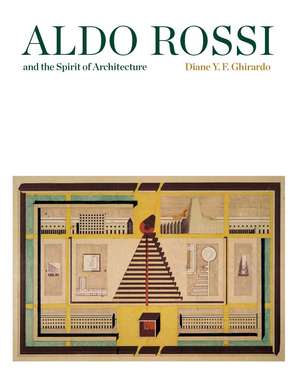Aldo Rossi and the Spirit of Architecture
Autor Diane Ghirardoen Limba Engleză Paperback – 14 mai 2024
An essential look at the Italian architect, writer, and designer whose work paved the way for the postmodern movement
Now available in paper, this crucial reassessment of Aldo Rossi’s (1931–1997) architecture examines his writings, drawings, and product design, including the coffeepots and clocks he designed for the Italian firm Alessi. The first Italian to receive the Pritzker Prize, Rossi rejected modernism, seeking instead a form of architecture that could transcend the aesthetic legacy of Fascism in postwar Italy. Rossi was a visionary who did not allow contemporary trends to dominate his thinking. His baroque sensibility and poetic approach, found both in his buildings and in important texts such as The Architecture of the City, inspired the critic Ada Louise Huxtable to describe him as “a poet who happens to be an architect.”
Diane Ghirardo explores different categories of structures—monuments, public buildings, cultural institutions, theaters, and cemeteries—drawing significantly on previously unpublished archival materials and always keeping Rossi’s own texts in the forefront. By delving into the relationships among Rossi’s multifaceted life, his rich body of work, and his own reflections, this book provides a critical understanding of Rossi’s buildings and the place of architecture in postwar Italy.
Now available in paper, this crucial reassessment of Aldo Rossi’s (1931–1997) architecture examines his writings, drawings, and product design, including the coffeepots and clocks he designed for the Italian firm Alessi. The first Italian to receive the Pritzker Prize, Rossi rejected modernism, seeking instead a form of architecture that could transcend the aesthetic legacy of Fascism in postwar Italy. Rossi was a visionary who did not allow contemporary trends to dominate his thinking. His baroque sensibility and poetic approach, found both in his buildings and in important texts such as The Architecture of the City, inspired the critic Ada Louise Huxtable to describe him as “a poet who happens to be an architect.”
Diane Ghirardo explores different categories of structures—monuments, public buildings, cultural institutions, theaters, and cemeteries—drawing significantly on previously unpublished archival materials and always keeping Rossi’s own texts in the forefront. By delving into the relationships among Rossi’s multifaceted life, his rich body of work, and his own reflections, this book provides a critical understanding of Rossi’s buildings and the place of architecture in postwar Italy.
Preț: 317.22 lei
Nou
Puncte Express: 476
Preț estimativ în valută:
60.70€ • 63.71$ • 50.38£
60.70€ • 63.71$ • 50.38£
Carte disponibilă
Livrare economică 20 martie-03 aprilie
Livrare express 05-11 martie pentru 53.60 lei
Preluare comenzi: 021 569.72.76
Specificații
ISBN-13: 9780300276732
ISBN-10: 0300276737
Pagini: 280
Ilustrații: 135 color + 5 b-w illus.
Dimensiuni: 203 x 254 x 15 mm
Greutate: 1 kg
Editura: Yale University Press
Colecția Yale University Press
ISBN-10: 0300276737
Pagini: 280
Ilustrații: 135 color + 5 b-w illus.
Dimensiuni: 203 x 254 x 15 mm
Greutate: 1 kg
Editura: Yale University Press
Colecția Yale University Press
Recenzii
“Two core issues, both embedded in the European and particularly Italian culture, constantly emerge in the work of Aldo Rossi. Diane Ghirardo enlightens them with particular precision and clarity: the relationship with history, a part of Europeans’ own genetic heritage, and with the city, and the cities of history of which everyone is inevitably heir and continuator.”—Raffaella Neri, The Plan Journal
“A masterpiece of analysis. Ghirardo’s book not only brings Rossi’s work to life, it is itself a demonstration piece of a type of architectural history that is increasingly missed in our day and age: the art of historicizing architecture from the building outward.”—Mark Jarzombek, Massachusetts Institute of Technology
“Diane Ghirardo makes a powerful claim about Rossi’s architectural achievements and artistic identity, locating his religious perspective and baroque sensibility at the root of his originality.”—Giuseppe Mazzotta, Yale University
“Ghirardo’s book is a remarkable account of Rossi’s work as understood through a close reading of the architect’s work and writing. It also serves as an impassioned call for historians to consider architectural projects and related creative output as the primary object of study.”—Lucy M. Maulsby, Northeastern University
“A masterpiece of analysis. Ghirardo’s book not only brings Rossi’s work to life, it is itself a demonstration piece of a type of architectural history that is increasingly missed in our day and age: the art of historicizing architecture from the building outward.”—Mark Jarzombek, Massachusetts Institute of Technology
“Diane Ghirardo makes a powerful claim about Rossi’s architectural achievements and artistic identity, locating his religious perspective and baroque sensibility at the root of his originality.”—Giuseppe Mazzotta, Yale University
“Ghirardo’s book is a remarkable account of Rossi’s work as understood through a close reading of the architect’s work and writing. It also serves as an impassioned call for historians to consider architectural projects and related creative output as the primary object of study.”—Lucy M. Maulsby, Northeastern University
Notă biografică
Diane Ghirardo is professor of the history and theory of architecture at the University of Southern California, Los Angeles. Her books include Architecture after Modernism (1996) and Italy: Modern Architectures in History (2013). She also translated Aldo Rossi’s The Architecture of the City (1984) into English from the original Italian.
Descriere
An essential look at the Italian architect, writer, and designer whose work paved the way for the postmodern movement
